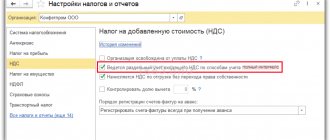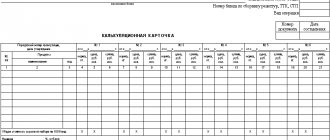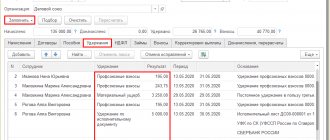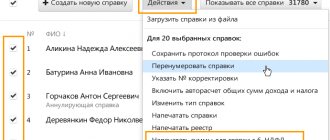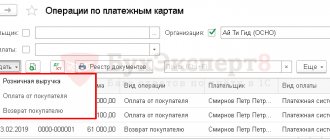Accounting for goods in trade
A product is an asset of an enterprise purchased exclusively for resale. For example, a company sells cars. That is, cars are bought and put up for sale in the showroom. This is a product. And if a company purchased a car, used it for a certain period of time, and then put it up for sale, then this is already a fixed asset. More information about fixed assets can be found in our section: → “Non-current assets”.
Accounting for inventory items is carried out on active-passive account 41 (see → “How to keep accounting records of the receipt of goods at the warehouse? Postings.”). The value of property can be reflected both at purchase prices and at sales prices.
Important! The chosen accounting method must be recorded in the organization's accounting policies.
Let's look at the pros and cons of each accounting method in more detail.
Accounting for goods at purchase prices
The purchase price accounting method is more typical for wholesale trade or retail sales of single goods, for example, household appliances or furniture. That is, when it is possible to track the batch and the purchase price of goods and materials: quantitative and total accounting. This approach will more correctly reflect the result of the transaction for each product, and if the company uses modern inventory accounting systems, then it is easy to organize accounting using this method even in a huge supermarket. But if the store is small, there are no automated systems, and the assortment is quite extensive, for example in grocery stores, then accounting for inventory items at purchase prices is a very labor- and time-consuming matter.
The disadvantages of this method include: (click to expand)
- Increased costs (automated systems or hiring a separate specialist);
- Time costs and errors during inventory;
- Errors in determining the retail price, because purchasing prices are constantly changing even from one supplier;
- Lack of efficiency, etc.
Therefore, inventory accounting in retail is most often carried out at sales prices.
Read in more detail: → “How to keep financial records? 7 examples."
Accounting for goods at sales prices
To organize accounting in this way, a markup is added to the purchase price, which is reflected in 42. This account is passive, that is, turnover is carried out only on credit.
Important! The trade margin is not taken into account in the balance sheet, and therefore the cost of inventory items is entered into the document only at purchase prices, regardless of the chosen method of accounting for goods.
The amount of the markup can be determined by:
- Adding a certain percentage to the purchase price;
- Adding the same amount to the price of each product;
- Establishing a single price for a certain type of product and subtracting purchases from it.
In retail, option 3 is most often used, since different suppliers may have different prices for the same product. And so that sellers do not get confused, a single price is set for it.
Documentarily, the amount of markup for each receipt of inventory items is reflected in the register of retail prices. The most convenient way is to draw up a new document for each receipt of goods. You can develop the form yourself. The following details must be specified:
- Title of the document;
- Date and number;
- Nomenclature;
- Purchase price;
- Extra charge;
- Selling price;
- Signatures of responsible persons.
Electronic document management in trade
Electronic document management or EDI is an automated system for exchanging documents between counterparties and regulatory authorities. They are created immediately in digital form.
The system protects data from modification and interception during transmission. Documents signed with a qualified electronic signature - CEP - have legal force. After signing, it is impossible to make changes or additional data to them, and you cannot delete part of the information. Thus, electronic document flow is more reliable than paper one.
Why do you need EDI when accepting goods?
The electronic document management system covers almost all areas of production. Simplifies primary accounting and financial reporting. The most commonly used universal transfer document is the UPD. It replaces the usual invoice, serves as the primary document and the basis for tax and accounting operations. The purpose of introducing UPD is to eliminate duplicate documentation and simplify record keeping.
Among the advantages:
- quick search of necessary data;
- instant exchange of information and legally relevant documentation;
- convenient archiving of data on the operator’s server.
Today there is no organization that cannot use digital document exchange. Such a system is needed to accept goods using electronic invoices. Moreover, for some product categories it is mandatory. For example, entrepreneurs working with products subject to mandatory labeling. Without connecting to an electronic document management system, it will be impossible to work with them. This requirement applies to shoes, tobacco, medicines, and perfumes.
What is UPD
The universal document was introduced in 2013, replacing the usual shipping documentation and invoice. It includes the details necessary to deduct VAT and confirm the fact of transfer of goods, work, or services.
The UPD contains the following information:
- basis for release of goods;
- Date of operation;
- list of nomenclature;
- dedicated VAT;
- signatures of the manager, responsible employee or other authorized persons.
You can use an electronic transfer document when moving goods and services, fixed assets, and material assets - this is indicated by the written instruction of the Federal Tax Service No. ММВ-20-3/96 dated October 21, 2013.
UPD statuses in EDF
A universal document in electronic document management reflects VAT, transfer of goods and materials, performance of work or services. An expanded set of details allows you to use the form for primary accounting as a basis for VAT deductions.
A universal document has three functional meanings:
- Status 1: Invoice (SCF function);
- Status 2: Invoice + primary document (SCFDOP function);
- Status 3: Primary document (DOP function).
Statuses are recorded in each digital document, which, depending on the value, go through different business processes. The universal form can be called a “constructor”, from which you can create the necessary document.
How does an electronic UPD differ from a paper one?
The electronic format of the document has the same legal force as the paper version. At the same time, it performs more functions. A universal transfer document can be used as an invoice, but a paper one cannot. It does not need to be printed, submitted on paper to reporting authorities, or stored in archival folders. It allows you to reduce the amount of packet data sent over telecommunication channels and reduces the cost of paying for transactions.
It is not the specific format of the document that makes any significant differences - it contains the advantages of electronic document management. EDI costs are significantly lower than the costs of paper document management. The purchase of printer consumables, maintenance of the device itself, and payment for postal or courier services are excluded.
It's also worth remembering that digital data exchange speeds up workflows, reduces response times, reduces the likelihood of errors and protects data. Not only the sender and recipient, but also the electronic document management operator are responsible for confidentiality.
How to connect to EDF
- Obtain an enhanced qualified electronic signature from an accredited certification center.
- Select an operator. Make sure it works with the markings and the "Honest Mark" system.
- Obtain from the operator the identifier (unique code) of the participant in the electronic document flow.
- Send invitations to your counterparties in the system to work remotely or accept invitations received from them.
Some organizations prefer to enter into additional agreements to the main agreements on the use of an electronic document management system. This is done at will; the law does not require it.
For EDI in trade, it is best to use ready-made services. The 1C-EDO product is suitable for those who use 1C programs. It allows you to exchange any documentation. You can work directly from the 1C program in the familiar interface without third-party applications.
The Astral Online web service is accessible from any device: PC and mobile gadgets. It works with marked products and any electronic signature. It doesn’t matter to users which operators their counterparties are connected to - the service provides free roaming.
Example #1. Retail Accounting
Verona LLC works for OSNO and has a retail store selling electrical goods. 07/08/2016 IP Blinov V.E. supplied 1 drill at a price of 3,345 rubles. per unit (including VAT 510.25 rubles). The markup is 30%, i.e. price of 1 drill 4,348.50 rub. (including VAT RUB 663.33). Let's look at how the transactions will look when accounting at purchase prices:
| Debit | Credit | Sum | Calculation | Wiring |
| 41 | 60 | 2 834,75 | 3 345 – 510,25 | The drill has arrived at the warehouse |
| 19 | 60 | 510,25 | VAT accepted for accounting | |
| 50 | 90.1 | 4 348,50 | Payment received at the cash register | |
| 90.3 | 68 | 663,33 | VAT charged | |
| 90.2 | 41 | 2 834,75 | The cost of 1 unit is written off. |
The balance sheet for account 90 is presented in the table below.
| check | rpm | Balance | ||
| Debit | Credit | Debit | Credit | |
| 90.1 | 4 348,50 | 4 348,50 | ||
| 90.2 | 2 834,75 | 2 834,75 | ||
| 90.3 | 663,33 | 663,33 | ||
| 90.9 | 3 498,08 | 4 348,50 | 850,42 | |
When accounting at retail prices, accounting for goods in retail trade is presented in the table below.
| Debit | Credit | Sum | Calculation | Wiring |
| 41 | 60 | 2 834,75 | 3 345 – 510,25 | The drill has been placed in the warehouse |
| 19 | 60 | 510,25 | VAT accepted for accounting | |
| 41 | 42 | 3 685,17 | 2 834,75 + 30% | Extra charge taken into account |
| 50 | 90.1 | 4 348,50 | Payment received at the cash register | |
| 90.3 | 68 | 663,33 | VAT charged | |
| 90.2 | 41 | 3 685,17 | The cost of 1 unit is written off. | |
| 90.2 | 42 | 850,42 | 3 685,17 – 2 834,75 | Reversal surcharge |
The balance sheet for account 90 is presented in the table below.
| check | rpm | Balance | ||
| Debit | Credit | Debit | Credit | |
| 90.1 | 4 348,50 | 4 348,50 | ||
| 90.2 | 2 834,75 | 2 834,75 | ||
| 90.3 | 663,33 | 663,33 | ||
| 90.9 | 3 498,08 | 4 348,50 | 850,42 | |
As we see, the financial result is the same. But in the case of accounting for inventory items in total terms at the average cost (without the use of automated systems), for example, if 3-5 batches of goods were received in a month at different prices, and the product range in the store is not 1 unit, but 2-3 hundreds, option 2 it will be much faster.
Cost accounting in trade
Trade enterprises keep track of expenses only on account 44 “Commercial expenses”, since they have neither main production nor general business expenses. Accounting is carried out according to articles.
Main expense items: (click to expand)
- Depreciation of fixed assets;
- Rent;
- Zar. pay;
- Taxes and fees;
- Advertising;
- Transport services, etc.
All expenses are recorded in the debit of the account, and at the end of the month they are closed to the financial result. This account can have a balance only for the costs of delivery of goods and materials. All other items are covered by posting Dt 90.2 Kt 44. Therefore, transport costs are often allocated to a separate subaccount.
Accounting for transport costs
The costs of services for the delivery of goods and materials (Inventory) can be taken into account in 2 ways:
- In the cost of goods with posting Debit 41 Credit 60 ;
- The costs are reflected by the entry Debit 44 Credit 60 .
The selected accounting option must be recorded in the enterprise's accounting policy.
If option 1 is selected, then the amount of costs for delivery of goods and materials is distributed among the entire product range of the delivered batch. It is most convenient to make the calculation in proportion to the cost of each type of inventory.
For example, 5 types of goods were received in the amount of 150 thousand rubles. The amount of the check for delivery is 30 thousand rubles.
| Product N | Cost of goods and materials (thousand rubles) | Amount of transportation costs (thousand rubles) | Calculation |
| 1 | 35 | 7 | 35×30÷150 |
| 2 | 25 | 5 | 25 ×30 ÷ 150 |
| 3 | 38 | 7,6 | 38 ×30 ÷ 150 |
| 4 | 29 | 5,8 | 29 × 30 ÷ 150 |
| 5 | 23 | 4,6 | 23 × 30 ÷ 150 |
| Total: | 150 | 30 |
That is, the price of N1 goods will no longer be 35 thousand rubles, but 42 thousand rubles. (35 +7), N 2 – 30 thousand rubles. (25 + 5), etc. Postings:
| Product N | Debit | Credit | Amount (thousand rubles) |
| 1 | 41 | 60 | 42 |
| 2 | 41 | 60 | 30 |
| 3 | 41 | 60 | 45,6 |
| 4 | 41 | 60 | 34,8 |
| 5 | 41 | 60 | 27,6 |
If the company has approved accounting option 2 and classifies transportation costs as expenses, then they do not need to be divided by type of inventory. All transport costs are grouped into account 44 during the month, at the end of which they are allowed to be divided in proportion to the goods sold. At the same time, at the end of the period, a final balance is allowed for this cost item, because only a part of the imported goods and materials was sold.
Example #2. Accounting for expenses and goods sold
Balance 44.01 “Transportation expenses” as of 06/01/2016 – 20 thousand rubles. During the month, transport services were received in the amount of 78 thousand rubles. That is, the balance as of June 30, 2016. – 98 thousand rubles. Inventory sold per month in the amount of 275 thousand rubles. Balance of unsold inventory items as of June 30, 2016. -35 thousand rubles. The amount of goods sold and remaining is 310 thousand rubles. (275 + 35).
Let's divide the final balance 44 by the amount of inventory items: 98 thousand rubles. ÷ 310 thousand rubles. = 0.316 (or 31.6%). That is, the amount of transportation costs in relation to the cost of goods and materials for the month amounted to 31.6%.
Accordingly, the balance of transport costs should be 31.6% in relation to the remaining inventory items. That is, 11 thousand rubles. (35 × 31.6%). The remaining amount of expenses: 87 thousand rubles. (98 – 11) – must be written off at the end of the month.
Accounting for financial results and subaccounts for retail trade
Absolutely every commercial structure is created for the purpose of making a profit. At the end of each month, the accounting department displays financial results and conducts “Month Closing”. For these purposes, account 90 with subaccounts is used. It is not reflected in the balance sheet and should not have a balance at the end of the month, but subaccounts are closed at the end of the year. Let's look at what subaccounts the 90th account has:
| Subaccount | Decoding |
| 1 | Revenue |
| 2 | Cost price |
| 3 | VAT |
| 4 | Excise taxes |
| 9 | Profit/loss |
90.1 – proceeds from the sale of inventory items are collected in this account during the month. This subaccount is credit only and is formed by the following transactions:
Dt 51 (50) Kt 90.1 – revenue received;
Dt 62 Kt 90.1 – goods and materials sold to a specific buyer.
90.2 – this account reflects the fact of writing off the cost of inventory items. All expenses incurred for the month are also covered. The account is debit and is formed by the following entries:
Dt 90.2 Kt 41 – the cost of inventory and materials is written off (based on sales);
Dt 90.2 Kt 44 – costs written off (at the end of the month).
90.3 – collects sold VAT, which must be transferred to the budget. In this case, the fact of payment does not affect the need to transfer VAT. That is, if the sale has taken place, but the buyer has not yet paid the money for the goods and materials, VAT must still be transferred by the 20th of the next month. This accounting method is called the “realization method.” Upon the fact of sale, you should issue an invoice, register it in the sales book and record it with the following entry:
Dt 90.3 Kt 68.2 VAT
However, in retail trade, the “Cash method” is most often used, since payment occurs at the time of transfer of inventory items. We have it in more detail below.
90.4 -Excise duties. This sub-account is dealt with by accountants whose companies sell highly profitable products: tobacco, oil, alcohol, etc. Wiring:
Dt 90.4 Kt 68 - excise duty
90.9 - Profit Loss. This subaccount is used to display financial results. It determines the difference between income and expenses incurred, that is, the profit or loss of the organization. Account balance 90.9 is closed monthly to account 99 by posting
Dt 90.9 Kt 99 – profit is reflected;
Dt 99 Kt 90.9 – loss received.
If we remember the initial example, then the Turnover Balance Sheet (SAS) for account 90 looked like this:
| check | rpm | Balance | ||
| Debit | Credit | Debit | Credit | |
| 90.1 | 4 348,50 | 4 348,50 | ||
| 90.2 | 2 834,75 | 2 834,75 | ||
| 90.3 | 663,33 | 663,33 | ||
| 90.9 | 3 498,08 | 4 348,50 | 850,42 | |
As a result of this operation, a profit was received in the amount of 850.42 rubles. That is, at the end of the month, the entire amount accumulated on account 90.3 must be written off to account 99. In this example the wiring is:
Dt 90.9 Kt 99 – 850.42 rub.
Commission trading
It happens that an organization does not sell its own goods, but goods and materials received for sale under a commission agreement. In this case, accounting in trade has a number of features that are imposed by commission trading. The commission agent's transactions will be completely different. For clarity, we have displayed the most basic accounting entries in the table:
| Operation | Account debit | Account credit |
| Admission to the commission | 004 “Goods on consignment” | |
| Commission sales | 50, 57, 62 | 76, subaccount “Settlements with the principal” |
| Write-off of realized commission values | 004 | |
| Expenses associated with commission sales that are not reimbursed by the consignor | 44 | 60, 10, 70, 69, etc. |
| Expenses associated with commission sales reimbursed by the principal | 76, subaccount “Settlements with the principal” | |
| Commission remuneration | 76, subaccount “Settlements with the principal” | 90, subaccount “Revenue” |
| VAT on revenue under a commission agreement | 90, subaccount “VAT” | 68 |
| Write-off of expenses associated with commission sales | 90, subaccount “Sales expenses” | 44 |
| Profit from the sale of goods at the end of the month | 90, subaccount “Profit/loss from sales” | 99 |
| Transfer of funds to the principal (minus the commission agent's remuneration and reimbursable expenses) | 76 | 51 |
Please note that the primary document for capitalization in accounting is the delivery note (form No. TORG-12). And account 004, which is used to capitalize inventory items on commission, is off-balance sheet. Accounting is carried out at the prices specified in the acceptance certificate by the committing organization.
Legal documents
- PBU 5/01
- Order of the Ministry of Finance dated October 31, 2000 No. 94n
What about VAT?
As we know, for each sale the seller is obliged to issue an invoice within 5 days (clause 3 of Article 168 of the Tax Code of the Russian Federation) and register it in the sales book. But what about retail stores? Do I need to issue an invoice to every customer? Of course not. According to point 7. Art. 168 of the Tax Code of the Russian Federation, the seller’s obligation to provide the buyer with an invoice is considered fulfilled if he has issued a cash document or BSO. This rule applies only for cash payments. At the same time, the total amount of the Z-report of the cash register tape is entered into the sales book. The recording is made at a frequency convenient for the company: every day, every 3 days, week, decade, at the end of the month or quarter.
If the buyer pays by bank transfer, the seller is obliged to issue and register an invoice in the sales book. After all, in paragraph 7 of Art. 168 of the Tax Code of the Russian Federation speaks only about transactions with cash.
The difference between retail and wholesale
First, let's figure out what kind of trade is considered retail. It seems that everything is simple: when a lot of goods are sold at once, then this is wholesale trade, and when individually or in small quantities, then this is retail. However, this is not really the difference between retail and wholesale By law, you are considered to be selling goods at retail if the buyer uses them for personal rather than business purposes. But as a seller, you are not obligated to control what the person who bought it from you does with the product. At the same time, you cannot sell at retail, for example, commercial or cash register equipment, that is, goods that cannot be used for personal purposes.
Retail trade differs from wholesale trade and the documentation that accompanies it. When selling goods at retail, you should not issue an invoice for the goods to the purchasing organization, otherwise the transaction may be considered wholesale.
How to arrange a retail sale without consequences
One of the main rules is issuing a payment document to the buyer. This may be a written purchase and sale agreement, a cash or sales receipt, or another document confirming payment (for example, a strict reporting form or a cash receipt order). In very rare cases, no documents are needed. Let's try to figure out how to arrange a retail sale without consequences. Let's consider all possible options.
Retail sales agreement
In fact, this agreement is mandatory for any retail sale transaction. But most often it does not have to be concluded in writing. For example, with a simple purchase in a store, this is done orally. The condition for the oral conclusion of a purchase and sale agreement is the coincidence of the moments of transfer of the goods to the buyer and its payment. As soon as a cash receipt or sales receipt is issued, the contract is considered concluded, and these documents, in turn, legally confirm it.
A written purchase and sale agreement is necessary when goods are purchased, for example, in installments, that is, the moments of transfer of goods and payment for them do not coincide. A contract fixed on paper is also mandatory when selling goods by sample or remotely.
Cash receipt
When selling goods at retail for cash or using payment cards, the seller is obliged to issue the buyer a cash receipt. Since 2020, new mandatory details have been added to the check.
The list of details should also include the OFD data to which the online cash register is connected - almost all entrepreneurs should install it. Even if you have a very small retail outlet, you can quickly and inexpensively organize a workplace for a cashier-seller. The MoySklad service offers a convenient modern solution for store automation. Just connect the fiscal recorder to your laptop - now you can punch out cash receipts!
Sales receipt
A sales receipt may also serve as confirmation of the conclusion of a retail purchase and sale agreement. With some exceptions, in most cases it may not be required. You are required to issue a sales receipt to the buyer if you peddle non-food items, as well as when selling furniture, weapons and ammunition, cars, motorcycles, trailers and numbered units. If the cash register receipt does not contain such information about the product as name, article number, grade, type and other characteristics, then the sales receipt is also required when selling:
- textile, sewing, knitted, fur products,
- technically complex household goods (communications, musical equipment, electrical appliances, etc.),
- precious metals and precious stones,
- animals and plants,
- building materials.
In addition, a sales receipt is issued upon the buyer's request.
This document is drawn up in any form. On our website you can also clarify the mandatory details that it must contain.

